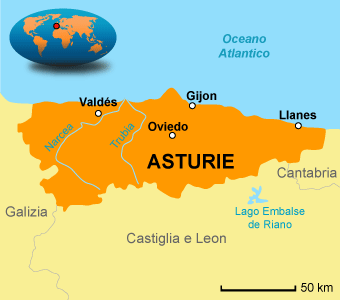Asturie è una piccola terra (supera di poco per estensione territoriale le nostre Marche) nella penisola iberica, affacciata sull’Atlantico e incastrata tra la Galizia e la Cantabria: una terra che va spopolandosi soprattutto nelle zone interne montagnose e rurali.

Oggi comunità autonoma della Spagna con capoluogo Oviedo un tempo terra degli Asturi, gli irriducibili celti che già costrinsero Caracalla a costituirla in provincia autonoma all’interno della Spagna citeriore romana. Finita in mano ai Visigoti fu il fulcro della resistenza cristiana all’invasione araba. Furono proprio i regnanti visigoti a costituire il Regno delle Asturie (occupando anche la Cantabrica e la Galizia con il resto delle terre centrali della penisola) eleggendo nel 718 re Pelagio (come narra la tradizione). Il regno delle Asturie alla morte di Alfonso III il Grande venne suddiviso nel Regno di León, di Galizia e delle Asturie e poi riunificato dai regnanti di Castiglia e Leon in quella che è la Spagna.
Accanto allo spagnolo si parla l’asturiano la lingua romanza del gruppo ibero-romanzo evolutasi dalle parlate tardo-latine della Spagna settentrionale.
[English translation]
Asturian is a small land in the Iberian peninsula, facing the Atlantic and nestled between Galicia and Cantabria: a land where the number of people is dropping in the mountainous and rural inland areas.
Today autonomous community of Spain with capital Oviedo once land of the Asturi, the irreducible Celts that already forced Caracalla to constitute it in the autonomous province within the Roman citeriore Spain. Finished in the hands of the Visigoths, it was the fulcrum of the Christian resistance to the Arab invasion. It was the Visigothic rulers who formed the Kingdom of Asturias (also occupying Cantabrica and Galicia with the rest of the central lands of the peninsula), electing King Pelagius in 718 (as tradition recounts). The kingdom of Asturias at the death of Alfonso III the Great was divided into the Kingdom of León, Galicia and Asturias and then reunited by the rulers of Castile and Leon in what is Spain.
Next to the Spanish, the Asturian is spoken of as the Romance language of the Ibero-Romance group evolved from the late-Latin dialects of northern Spain.
Festival Interceltico di Avilés e della Comarca
Si tiene ad Avilés nel mese di Luglio è uno dei più importanti festival delle Asturie oltre che una grande festa celtica sulla scia del Festival Interceltico di Lorient in Bretagna.
Musica tradizionale asturiana
Gli strumenti più popolari sono la cornamusa e il tamburo nella versione asturiana suonati in coppia. Arrivano poi il flauto traverso in legno, il violino e la fisarmonica, e tra gli strumenti più medievali il rabel (un violino a tre corde che si suona a gamba o come il fiddle) e il tamburo di forma quadrata utilizzato per l’accompagnamento delle vanqueirada di montagna. I canti popolari sono per lo più canti corali (gruppi di 3, 4 e 8 voci).
Le melodie a ballo sono le muñeira (giga in 6/8 o 9/8), il saltón e la alborada (in 2/ e 4/4) e la xota cioè la jota spagnola (3/8) oltre a i ritmi europei più comuni come valzer, polca e mazurca. Ovviamente declinate nelle diverse e tipiche tecniche strumentali e melodiche.
Alcune delle tipiche danze asturiane sono state esportate nella Spagna meridionale dopo l’espulsione dei Mori dalla penisola, in seguito alla migrazione, come il fandango che però è diverso da quello andalusiano (dal quale deriverà il flamenco).
[English translation]
The most popular instruments are the bagpipe and the drum in the Asturian version played in couple. Then come the wooden transverse flute, the violin and the accordion, and among the most medieval instruments the rabel and the square-shaped drum used to accompany the mountain vanqueirada. The folk songs are mostly choir songs (groups of 3, 4 and 8 voices).
The melodies to dance are the muñeira (giga in 6/8 or 9/8), the saltón and the alborada (in 2 / 4/4) and the xota that is the Spanish jota (3/8) in addition to the European rhythms more common as waltzes, polca and mazurca. Obviously declined in the different and typical instrumental and melodic techniques.
Some of the typical Asturian dances were exported to southern Spain after the emigration of the Moors from the peninsula, such as the fandango which is however different from the Andalusian one (from which flamenco will derive).
ARCHIVIO MUSICISTI
I gruppi folk sono numerosi e ancora cavalcano l’onda lunga del revival asturiano degli anni 70
Brenga Astur
Felpeyu
Hevia
Llan de Cubel
Tejedor
Xuacu Amieva
LINK
http://www.oilproject.org/lezione/i-regni-cristiani-nelle-asturie-21357.html
